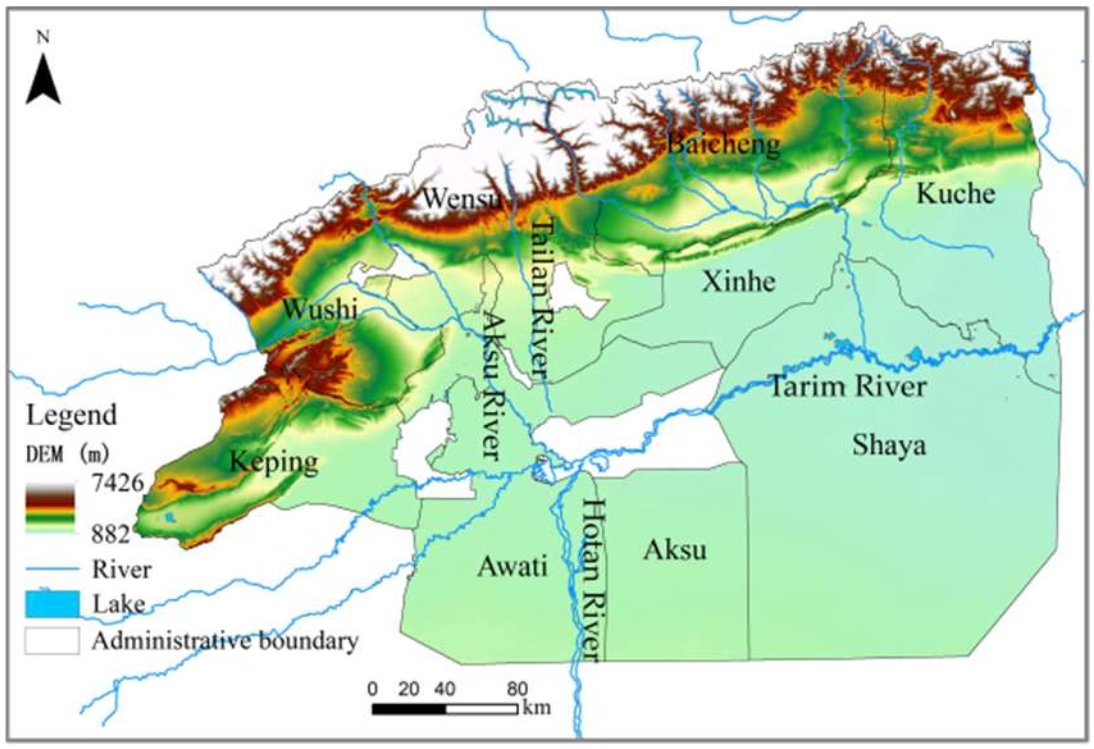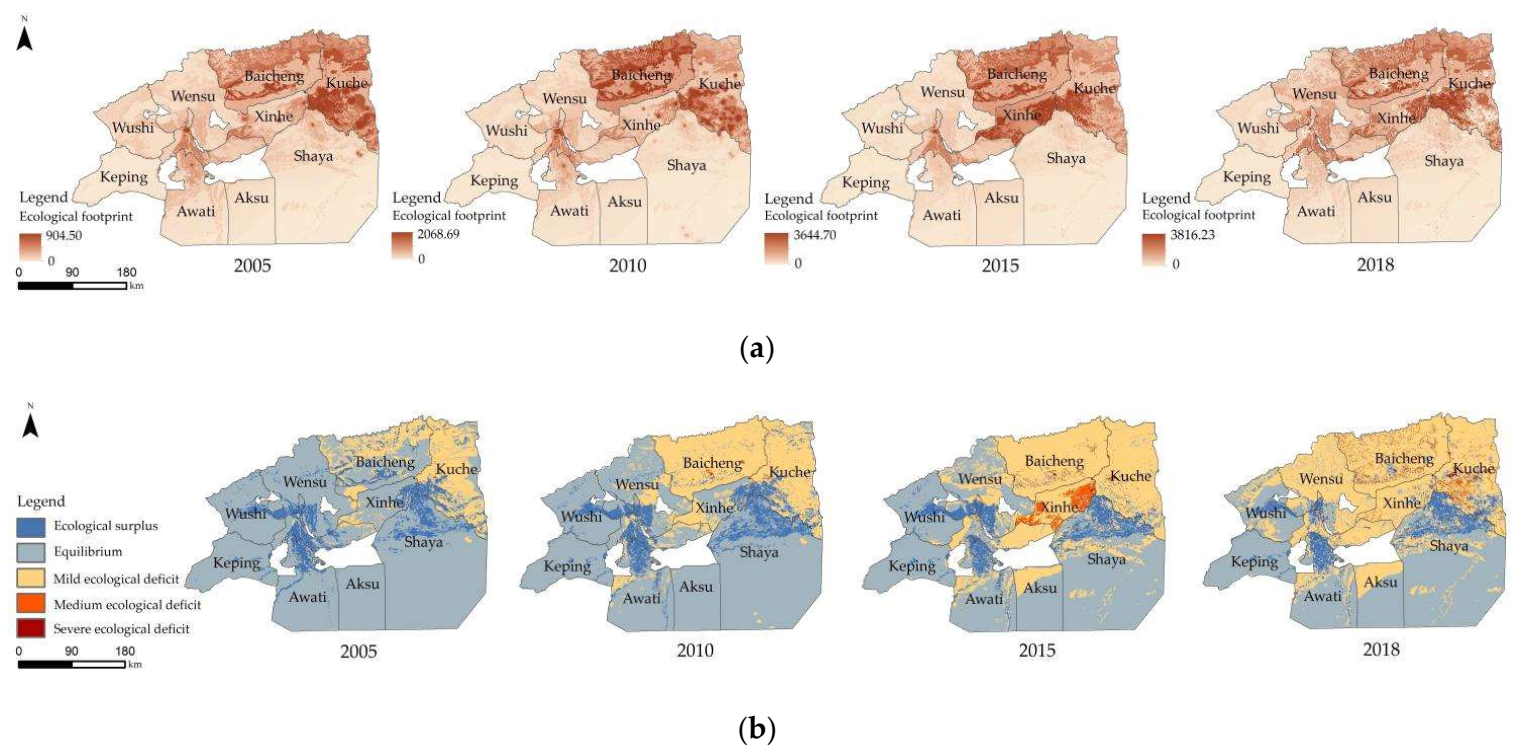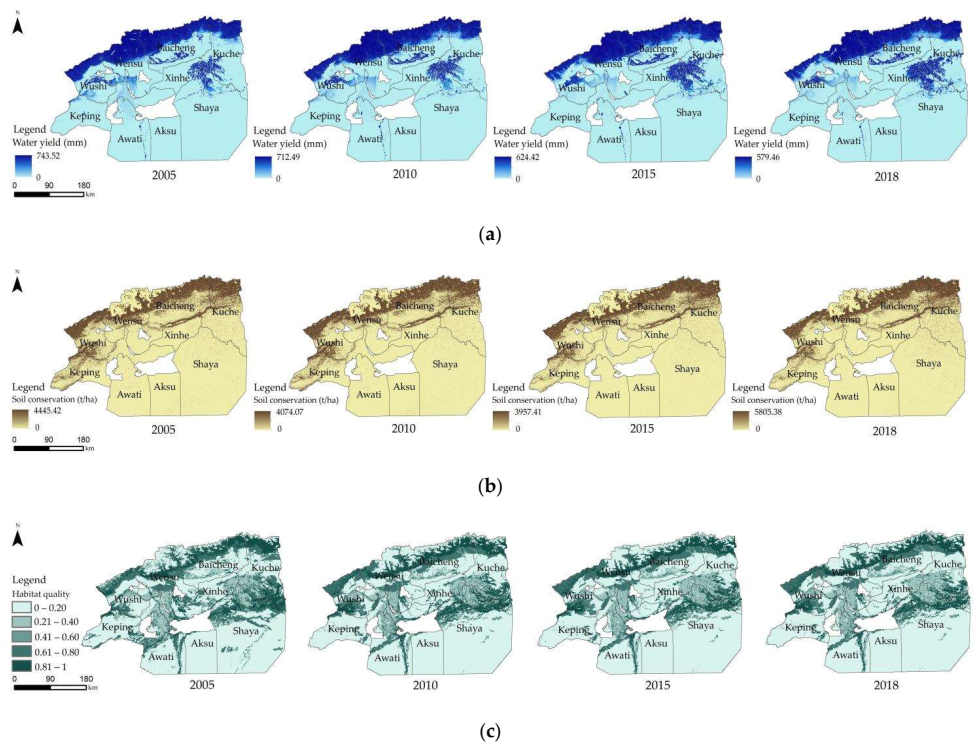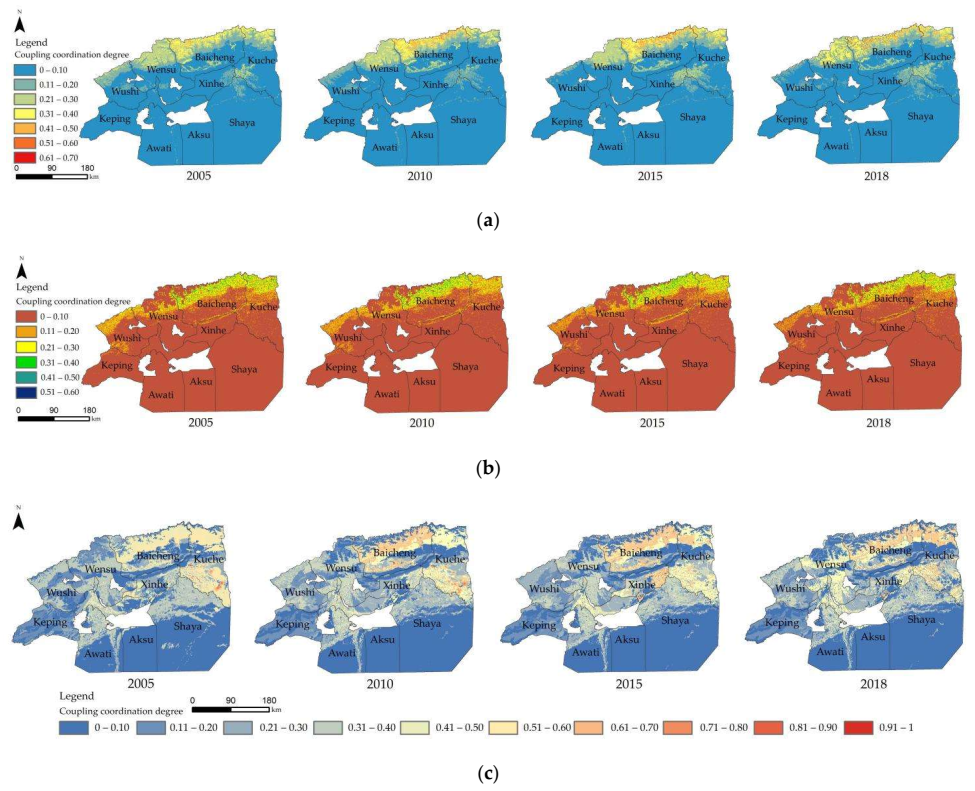Spatio-temporal Differentiation of Coupling Coordination between Ecological Footprint and Ecosystem Service Functions in the Aksu Region, Xinjiang, China
Abstract
:1. Introduction
2. Materials and Methods
2.1. Study Area
2.2. Data Sources
2.3. Methods
2.3.1. Ecological Footprint Model
2.3.2. InVEST Model
- (1)
- Water supply
- (2)
- Soil conservation
- (3)
- Habitat quality
2.3.3. Coupling Coordination Degree Model
2.3.4. Spatial Statistical Analysis
3. Results and Analysis
3.1. Spatial–Temporal Differentiation of the Ecological Footprint
3.2. Spatial–Temporal Differentiation of the Ecosystem Service Functions
3.3. Spatial–Temporal Differentiation of the Coupling Coordination between Ecological Footprint and Ecosystem Service Functions
3.4. Analysis of the Spatial Clustering Characteristics
4. Discussion
5. Conclusions
- The per capita ecological footprint and biocapacity of the Aksu region increased from 2005 to 2018, and the per capita ecological footprint significantly grew higher than the per capita biocapacity, resulting in the gradual shift of the region from an ecological surplus to an ecological deficit. Meanwhile, the regional per capita GDP gradually increased, but the ecological footprint of CNY 10,000 GDP slowly decreased, indicating that the resource utilization efficiency of the Aksu region had improved.
- The ecological footprint of the Aksu region is high in the northeast and low in the southwest, and the spatial heterogeneity is noticeable. Carbon (66.17%) and cropland (26.64%) are the main contributors to the regional ecological footprint. The biocapacity is dominated by cropland, built-up land, and forest land. The regional average ecological footprint from 2005 to 2018 increased from 28.82 ha to 117.46 ha per grid cell, and the biocapacity steadily changed, resulting in an increasing regional ecological deficit.
- The ecosystem service functions in the Aksu region are high in the north and low in the south, with significant regional differences. The ecosystem services in Wushi County, Wensu County, Baicheng County, and the northern part of Kuqa City on the southern slope of the Tianshan Mountains are relatively higher compared with that in the Taklimakan Desert at the southern part of the study area. This function is mainly affected by rainfall, evapotranspiration, land use type, and vegetation coverage. The water supply and biodiversity maintenance functions showed a decreasing trend within the study period.
- The coupling coordination degree of the ecological footprint and ecosystem service functions in the Aksu region is high in the north and low in the south, which is dominated by the spatial pattern of ecosystem services. The coupling relationship between the ecological footprint and habitat quality is the strongest, while that between the ecological footprint and water supply and soil conservation is weak. The coordination degree between the ecological footprint and water supply function increased within the study period; however, the coordination degree between the ecological footprint and soil conservation function and biodiversity conservation function decreased. In addition, the coupling coordination degree had evident spatial agglomeration characteristics.
Author Contributions
Funding
Institutional Review Board Statement
Informed Consent Statement
Data Availability Statement
Conflicts of Interest
References
- Rudolph, A.; Figge, L. Determinants of ecological footprints: What is the role of globalization? Ecol. Indic. 2017, 81, 348–361. [Google Scholar] [CrossRef]
- Jorgenson, A.K.; Clark, B. Are the Economy and the Environment Decoupling? A Comparative International Study, 1960–2005. Am. J. Sociol. 2012, 118, 1–44. [Google Scholar] [CrossRef]
- Qin, C.; Tang, Z.; Chen, J.; Chen, X. The Impact of Soil and Water Resource Conservation on Agricultural Production- an Analysis of the Agricultural Production Performance in Zhejiang, China. Agric. Water Manag. 2020, 240, 106268. [Google Scholar] [CrossRef]
- Mahmoud, S.H.; Gan, T.Y. Impact of anthropogenic climate change and human activities on environment and ecosystem services in arid regions. Sci. Total Environ. 2018, 633, 1329–1344. [Google Scholar] [CrossRef] [PubMed]
- Wang, K.; Deng, L.; Shangguan, Z.; Chen, Y.; Lin, X. Sustainability of eco-environment in semi-arid regions: Lessons from the Chinese Loess Plateau. Environ. Sci. Policy 2021, 125, 126–134. [Google Scholar] [CrossRef]
- Liu, J.; Tian, Y.; Huang, K.; Yi, T. Spatial-temporal differentiation of the coupling coordinated development of regional energy-economy-ecology system: A case study of the Yangtze River Economic Belt. Ecol. Indic. 2021, 124, 107394. [Google Scholar] [CrossRef]
- Fan, Y.; Fang, C.; Zhang, Q. Coupling coordinated development between social economy and ecological environment in Chinese provincial capital cities-assessment and policy implications. J. Clean. Prod. 2019, 229, 289–298. [Google Scholar] [CrossRef]
- Wackernagel, M.; McIntosh, J.; Rees, W.E.; Woollard, R. How Big is Our Ecological Footprint? A Handbook for Estimating a Community’s Appropriated Carrying Capacity; Discussion draft of the Task Force on Planning Healthy and Sustainable Communities; University of British Columbia: Vancouver, BC, Canada, 1993. [Google Scholar]
- Costanza, R. Ecological economics in 2049: Getting beyond the argument culture to the world we all want. Ecol. Econ. 2020, 168, 106484. [Google Scholar] [CrossRef]
- Mancini, M.; Galli, A.; Niccolucci, V.; Lin, D.; Hanscom, L.; Wackernagel, M.; Bastianoni, S.; Marchettini, N. Stocks and flows of natural capital: Implications for Ecological Footprint. Ecol. Indic. 2017, 77, 123–128. [Google Scholar] [CrossRef]
- Rees, W.E. Ecological footprints and appropriated carrying capacity: What urban economics leaves out. Environ. Urban 1992, 4, 121–130. [Google Scholar] [CrossRef]
- Wackernagel, M. Our Ecological Footprint: Reducing Human Impact on the Earth; New Society Publishers: Gabriola Island, BC, Canada, 1996. [Google Scholar]
- Silvio, F.; Barbara, P.; Angelo, M. Mapping National Environmental Sustainability Distribution by Ecological Footprint: The Case of Italy. Sustainability 2021, 13, 8671. [Google Scholar] [CrossRef]
- Gu, Y.; Ding, J.; Li, A. Spatio-temporal difference of coupling coordination degree of productive ecological carrying capacity and ecological function coupling in Baoding, Hebei province. Acta Ecol. Sinica 2020, 40, 7175–7186. [Google Scholar] [CrossRef]
- Korkut, P.; Veli, Y. Investigating the persistence of shocks on the ecological balance: Evidence from G10 and N11 countries. Sustain. Prod. Consum. 2021, 28, 624–636. [Google Scholar] [CrossRef]
- Galli, A.; Iha, K.; Pires, S.; Alves, A.; Zokai, G.; Lin, D.; Murthy, A.; Wackernagel, M. Assessing the Ecological Footprint and biocapacity of Portuguese cities: Critical results for environmental awareness and local management. Cities 2020, 96, 102442. [Google Scholar] [CrossRef]
- Neagu, O. Economic Complexity and Ecological Footprint: Evidence from the Most Complex Economies in the World. Sustainability 2020, 12, 9031. [Google Scholar] [CrossRef]
- Bherwani, H.; Nair, M.; Niwalkar, A.; Balachandran, D.; Kumar, R. Application of circular economy framework for reducing the impacts of climate change: A case study from India on the evaluation of carbon and materials footprint nexus. Energy Nexus 2022, 5, 100047. [Google Scholar] [CrossRef]
- Mo, L.; Chen, J.; Xie, Y. Ecological Approach for the Evaluation of Structure and Sustainability in the Tourism Industry. Sustainability 2021, 13, 13294. [Google Scholar] [CrossRef]
- Wang, H.; Huang, J.; Zhou, H.; Deng, C.; Fang, C. Analysis of sustainable utilization of water resources based on the improved water resources ecological footprint model: A case study of Hubei Province, China. J. Environ. Manag. 2020, 262, 110331. [Google Scholar] [CrossRef]
- Altiok, S.; Murthy, A.; Iha, K.; Galli, A. Reducing Mediterranean Seafood Footprints: The role of consumer attitudes. Ocean. Coast. Manag. 2021, 214, 105915. [Google Scholar] [CrossRef]
- Niccolucci, V.; Galli, A.; Reed, A.; Neri, E.; Wackernagel, M.; Bastianoni, S. Towards a 3D national ecological footprin tgeography. Ecol. Model. 2011, 222, 2939–2944. [Google Scholar] [CrossRef]
- Galli, A.; Wackernagel, M.; Iha, K.; Lazarus, E. Ecological Footprint: Implications for biodiversity. Biol. Conserv. 2014, 173, 121–132. [Google Scholar] [CrossRef]
- Collins, A.; Galli, A.; Hipwood, T.; Murthy, A. Living within a One Planet reality: The contribution of personal Footprint calculators. Environ. Res. Lett. 2020, 15, 025008. [Google Scholar] [CrossRef]
- Costanza, R.; De Groot, R.; Sutton, P.; Van der Ploeg, S.; Anderson, S.J.; Kubiszewski, I.; Farber, S.; Turner, R.K. Changes in the Global Value of Ecosystem Services. Glob. Environ. Change 2014, 26, 152–158. [Google Scholar] [CrossRef]
- Woldeyohannes, A.; Cotter, M.; Biru, W.; Kelbor, G. Assessing Changes in Ecosystem Service Values over 1985–2050 in Response to Land Use and Land Cover Dynamics in Abaya-Chamo Basin, Southern Ethiopia. Land 2020, 9, 37. [Google Scholar] [CrossRef] [Green Version]
- Huang, X.; Chen, Y.; Ma, J.; Hao, X. Research of the Sustainable Development of Tarim River Based on Ecosystem Service Function. Procedia Environ. Sci. 2011, 10, 239–246. [Google Scholar] [CrossRef] [Green Version]
- He, F.; Jin, J.; Zhang, H.; Yuan, L. The change of ecological service value and the promotion mode of ecological function in mountain development using InVEST model. Arab. J. Geosci. 2021, 14, 510. [Google Scholar] [CrossRef]
- Guerry, A.D.; Ruckelshaus, M.H.; Arkema, K.K.; Bernhardt, J.R.; Guannel, G.; Kim, C.K.; Marsik, M.; Day, A.; Tallis, H.; Spencer, J.; et al. Modeling Benefits from Nature: Using Ecosystem Services to Inform Coastal and Marine Spatial Planning. Int. J. Biodivers. Sci. Ecosyst. Serv. Manag. 2012, 8, 107–121. [Google Scholar] [CrossRef] [Green Version]
- Brown, G.; Brabyn, L. The extrapolation of social landscape values to a national level in New Zealand using landscape character classification. Appl. Geogr. 2012, 35, 84–94. [Google Scholar] [CrossRef]
- Arunyawat, S.; Shrestha, R. Assessing Land Use Change and Its Impact on Ecosystem Services in Northern Thailand. Sustainability 2016, 8, 768. [Google Scholar] [CrossRef] [Green Version]
- Gashawa, T.; Bantider, A.; Zeleke, G.; Alamirew, T.; Jemberu, W.; Worqlul, A.; Dile, Y.; Bewket, W.; Meshesha, D.; Adem, A.; et al. Evaluating InVEST model for estimating soil loss and sediment export in data scarce regions of the Abbay (Upper Blue Nile) Basin: Implications for land managers. Environ. Chall. 2021, 5, 100381. [Google Scholar] [CrossRef]
- Leh, M.; Matlock, M.; Cummings, E.; Nalley, L. Quantifying and mapping multiple ecosystem services change in West Africa. Agric. Ecosyst. Environ. 2013, 165, 6–18. [Google Scholar] [CrossRef]
- Daneshi, A.; Brouwer, R.; Najafinejad, A.; Panahi, M.; Zarandian, A.; Maghsood, F.F. Modelling the impacts of climate and land use change on water security in a semi-arid forested watershed using InVEST. J. Hydrol. 2021, 593, 125621. [Google Scholar] [CrossRef]
- Zhang, F.; Li, X.; Feng, Q.; Wang, H.; Wei, Y.; Bai, H. Spatial and Temporal Variation of Water Conservation in the Upper Reaches of Heihe River Basin Based on InVEST Model. J. Desert Res. 2018, 38, 1321–1329. [Google Scholar] [CrossRef]
- He, C.; Zhang, D.; Huang, Q.; Zhao, Y. Assessing the potential impacts of urban expansion on regional carbon storage by linking the LUSD-urban and InVEST models. Environ. Model. Softw. 2016, 75, 44–58. [Google Scholar] [CrossRef]
- Liang, Y.; Liu, L.; Huang, J. Integrating the SD-CLUE-S and InVEST models into assessment of oasis carbon storage in northwestern China. PLoS ONE 2017, 12, e0172494. [Google Scholar] [CrossRef]
- Wang, B.; Zhao, J.; Hu, X. Spatial pattern analysis of ecosystem services based on InVEST in Heihe River Basin. Chin. J. Ecol. 2016, 35, 2783–2792. [Google Scholar] [CrossRef]
- Ding, C.; Zhang, H.; Li, X.; Li, W.; Gao, Y. Quantitative assessment of water conservation function of the natural spruce forest in the central Tianshan Mountains: A case study of the Urumqi River Basin. Acta Ecol. Sin. 2017, 37, 3733–3743. [Google Scholar] [CrossRef] [Green Version]
- Li, P.; Zhang, R.; Wei, H.; Xu, L. Assessment of physical quantity and value of natural capital in China since the 21st century based on a modified ecological footprint model. Sci. Total Environ. 2021, 806, 150676. [Google Scholar] [CrossRef]
- Mancini, M.; Galli, A.; Coscieme, L.; Niccolucci, V.; Lin, D.; Pulselli, F.; Bastianoni, S.; Marchettini, N. Exploring ecosystem services assessment through Ecological Footprint accounting. Ecosyst. Serv. 2018, 30, 228–235. [Google Scholar] [CrossRef]
- Ariken, M.; Zhang, F.; Chan, N.; Kung, H.-T. Coupling coordination analysis and spatio-temporal heterogeneity between urbanization and eco-environment along the silk road economic belt in China. Ecol. Indic. 2021, 121, 107014. [Google Scholar] [CrossRef]
- Fu, J.; Zhang, Q.; Wang, P.; Zhang, L.; Tian, Y.; Li, X. Spatio-Temporal Changes in Ecosystem Service Value and Its Coordinated Development with Economy: A Case Study in Hainan Province, China. Remote Sens. 2022, 14, 970. [Google Scholar] [CrossRef]
- National Science and Technology Infrastructure Platform Construction—National Earth System Science Data Center. Available online: http://www.geodata.cn (accessed on 20 February 2022).
- Global Footprint Network. National Footprint and Biocapacity Accounts. Available online: https://www.footprintnetwork.org/resources/data/ (accessed on 1 August 2020).
- Liu, T.; Wang, H.-Z.; Wang, H.-Z.; Xu, H. The spatiotemporal evolution of ecological security in China based on the ecological footprint model with localization of parameters. Ecol. Indic. 2021, 126, 107636. [Google Scholar] [CrossRef]
- Lin, C.; Li, X.; Yang, N.; Li, E.; Du, P. A Study on Spatial Pattern of Ecological Footprint for Urban Agglomeration Combinedwith Remote Sensing Products: A Case Study of Urban Agglomeration in the Yangtze River Delta. Geogr. Geo-Inf. Sci. 2018, 34, 20–25+130. [Google Scholar] [CrossRef]
- Guo, J.; Ren, J.; Huang, X.; He, G.; Shi, Y.; Zhou, H. The Dynamic Evolution of the Ecological Footprint and Ecological Capacity of Qinghai Province. Sustainability 2020, 12, 3065. [Google Scholar] [CrossRef] [Green Version]
- Li, P.; Xu, L.; Zhang, J.; Jin, M.; Zhang, R. Spatio-temporal changes of three-dimensional ecological footprint in inland river basins in Arid Region: A case study of the Manas River Basin. Acta Ecol. Sin. 2020, 40, 6776–6787. [Google Scholar] [CrossRef]
- Xu, C.; Cao, Y.; Xu, Z.; Yang, J.; Zeng, Z. A Study on Identification Methods of Ecological Source Area in Aksu Area, Xinjiang Uygur Autonomous Region. Bull. Soil Water Conserv. 2021, 41, 174–181+188. [Google Scholar] [CrossRef]
- Aneseyee, A.; Elias, E.; Soromessa, T.; Feyisa, G. Land use/land cover change effect on soil erosion and sediment delivery in the Winike watershed, Omo Gibe Basin, Ethiopia. Sci. Total Environ. 2020, 728, 138776. [Google Scholar] [CrossRef]
- Cai, C.; Ding, S.; Shi, Z.; Huang, L.; Zhang, G. Study of Applying USLE and Geographical Information System IDRISI to Predict Soil Erosion in Small Watershed. J. Soil Water Conserv. 2000, 14, 19–24. [Google Scholar] [CrossRef]
- Hack, J.; Molewijk, D.; Beißler, M.R. A Conceptual Approach to Modeling the Geospatial Impact of Typical Urban Threats on the Habitat Quality of River Corridors. Remote Sens. 2020, 12, 1345. [Google Scholar] [CrossRef] [Green Version]
- Deng, M.; Chen, J.; Tao, F.; Zhu, J.; Wang, M. On the Coupling and Coordination Development between Environment and Economy: A Case Study in the Yangtze River Delta of China. Int. J. Environ. Res. Public Health 2022, 19, 586. [Google Scholar] [CrossRef]
- Tobler, W. A Computer Movie Simulating Urban Growth in the Detroit Region. Econ. Geogr. 1970, 46, 234–240. [Google Scholar] [CrossRef]
- Ji, J.; Tang, Z.; Zhang, W.; Liu, W.; Jin, B.; Xi, X.; Wang, F.; Zhang, R.; Guo, B.; Xu, Z.; et al. Spatiotemporal and Multiscale Analysis of the Coupling Coordination Degree between Economic Development Equality and Eco-Environmental Quality in China from 2001 to 2020. Remote Sens. 2022, 14, 737. [Google Scholar] [CrossRef]
- Wiedmann, T.; Lenzen, M. On the conversion between local and global hectares in Ecological Footprint analysis. Ecol. Econ. 2007, 60, 673–677. [Google Scholar] [CrossRef]
- Kitzes, J.; Galli, A.; Bagliani, M.; Barrett, J.; Dige, G.; Ede, S.; Erb, K.; Giljum, S.; Haberl, H.; Hails, C.; et al. A research agenda for improving national Ecological Footprint accounts. Ecol. Econ. 2009, 68, 1991–2007. [Google Scholar] [CrossRef]
- Liu, Y.; Zhu, Z.; Jia, G. Study on Carrying Capacity of Arid Zone in Central Ningxia Based on the Sub-National Hectare Ecological Footprint. Res. Soil Water Conserv. 2017, 24, 357–362. [Google Scholar] [CrossRef]
- Wang, L.; Zhou, Y.; Chen, J. Ecological Capacity and Ecological Security of Aksu Prefecture. Environ. Prot. Xinjiang 2017, 39, 45–50. [Google Scholar] [CrossRef]
- Jin, M.; Xu, L.; Li, P. Spatial and temporal evolution of natural capital utilization in the three-dimensionalecological footprint under the regional economic differentiation in north and south Xinjiang. Acta Ecol. Sin. 2020, 40, 4327–4339. [Google Scholar] [CrossRef]
- Zang, J.; Zhang, T.; Chen, L.; Li, L.; Liu, W.; Yuan, L.; Zhang, Y.; Liu, R.; Wang, Z.; Yu, Z.; et al. Optimization of Modelling Population Density Estimation Based on Impervious Surfaces. Land 2021, 10, 791. [Google Scholar] [CrossRef]
- Yang, Y.; Fan, M. Analysis of spatial and temporal differences and equity of ecological footprints of provinces along the Silk Road Economic Belt in China. Acta Ecol. Sin. 2019, 39, 5040–5050. [Google Scholar] [CrossRef]
- Liu, M.; Li, W. Calculation of Equivalence Factor Used in Ecological Footprint for China and Its Provinces Based on Net Primary Production. J. Ecol. Rural. Environ. 2010, 26, 401–406. [Google Scholar] [CrossRef]
- Liu, M.; Li, W.; Xie, G. Estimation of China ecological footprint production coefficient based on net primary productivity. Chin. J. Ecol. 2010, 29, 592–597. [Google Scholar] [CrossRef]
- Sun, Q.; Xu, C.; Ren, Z.; Chu, Z. Spatiotemporal Variation in Water Yield and Their Underlying Mechanisms in Tarim River Basin. J. Irrig. Drain. 2021, 40, 114–122. [Google Scholar] [CrossRef]
- Guo, L.; Yin, X.; Gou, Z.; Gao, J. Evaluation on water yield and analysis of its variation characteristics of Arku River Basin based on In VEST model. J. Shihezi Univ. 2020, 38, 216–224. [Google Scholar] [CrossRef]
- Siche, R.; Pereira, L.; Agostinho, F.; Ortega, E. Convergence of ecological footprint and emergy analysis as a sustainability indicator of countries: Peru as case study. Commun. Nonlinear Sci. Numer. Simul. 2010, 15, 3182–3192. [Google Scholar] [CrossRef]
- Ozturk, I.; Al-Mulali, U.; Saboori, B. Investigating the environmental Kuznets curve hypothesis: The role of tourism and ecological footprint. Environ. Sci. Pollut. Res. Int. 2016, 23, 1916–1928. [Google Scholar] [CrossRef]
- Deng, C.; Liu, Z.; Li, R.; Li, K. Sustainability Evaluation Based on a Three-Dimensional Ecological Footprint Model: A Case Study in Hunan, China. Sustainability 2018, 10, 4498. [Google Scholar] [CrossRef] [Green Version]







| Account | Land Type | Subaccount | Equilibrium Factors | Yield Factors |
|---|---|---|---|---|
| Biological resources account | Cropland | Land of providing agricultural products (food crops, economic crops, and fruit melons) and some livestock products (pork, poultry meat, and eggs) for the region. | 3.83 | 0.96 |
| Forest land | Land of providing forest products (apples, pears, grapes, apricots, peaches, dates, walnuts, etc.) for the region. | 1.16 | 1.14 | |
| Grazing land | Land of providing most of the livestock products (beef, lamb, milk, etc.) for the region. | 0.06 | 1.89 | |
| Fishing ground | Waters of providing aquatic products (fish, shrimp, crab, shellfish, etc.) for the region. | 0.03 | 1.49 | |
| Energy account | Built-up land | Land of providing urban and rural housing, transportation, water conservancy, communications, and other infrastructures for the region. | 3.83 | 0.96 |
| Carbon-uptake land | Land of absorbing carbon dioxide from the combustion of fossil fuels (raw coal, coke, natural gas, crude oil, gasoline, diesel, etc.) for the region. | 1.08 | 0.00 |
| Coupling Coordination Degree | 2005 | 2010 | ||||
|---|---|---|---|---|---|---|
| Moran’s I | Z | p | Moran’s I | Z | p | |
| Ecological footprint and water supply function | 0.889 | 358.43 | <0.001 | 0.904 | 380.20 | <0.001 |
| Ecological footprint and soil conservation function | 0.802 | 509.73 | <0.001 | 0.801 | 544.51 | <0.001 |
| Ecological footprint and habitat quality | 0.518 | 148.05 | <0.001 | 0.707 | 308.41 | <0.001 |
| Coupling Coordination Degree | 2015 | 2018 | ||||
| Moran’s I | Z | p | Moran’s I | Z | p | |
| Ecological footprint and water supply function | 0.905 | 410.46 | <0.001 | 0.779 | 309.42 | <0.001 |
| Ecological footprint and soil conservation function | 0.817 | 550.85 | <0.001 | 0.770 | 525.77 | <0.001 |
| Ecological footprint and habitat quality | 0.717 | 338.20 | <0.001 | 0.539 | 235.29 | <0.001 |
| Land Use Type | Equilibrium Factors | Yield Factors | ||||
|---|---|---|---|---|---|---|
| Local Parameters | Provincial Parameters [63] | National Parameters [64] | Local Parameters | Provincial Parameters | National Parameters [65] | |
| Cropland | 3.83 | 2.25 | 2.52 | 0.96 | 0.74 | 1.32 |
| Forest land | 1.16 | 2.36 | 1.28 | 1.14 | 0.97 | 2.55 |
| Grazing land | 0.06 | 0.42 | 0.43 | 1.89 | 0.54 | 1.93 |
| Fishing ground | 0.03 | 0.33 | 0.35 | 1.49 | 0.54 | 1.00 |
| Built-up land | 3.83 | 2.25 | 2.52 | 0.96 | 0.74 | 1.32 |
| Carbon-uptake land | 1.08 | 2.36 | 1.28 | – | – | – |
Publisher’s Note: MDPI stays neutral with regard to jurisdictional claims in published maps and institutional affiliations. |
© 2022 by the authors. Licensee MDPI, Basel, Switzerland. This article is an open access article distributed under the terms and conditions of the Creative Commons Attribution (CC BY) license (https://creativecommons.org/licenses/by/4.0/).
Share and Cite
Xu, H.; Yang, J.; Xia, G.; Lin, T. Spatio-temporal Differentiation of Coupling Coordination between Ecological Footprint and Ecosystem Service Functions in the Aksu Region, Xinjiang, China. Sustainability 2022, 14, 3483. https://doi.org/10.3390/su14063483
Xu H, Yang J, Xia G, Lin T. Spatio-temporal Differentiation of Coupling Coordination between Ecological Footprint and Ecosystem Service Functions in the Aksu Region, Xinjiang, China. Sustainability. 2022; 14(6):3483. https://doi.org/10.3390/su14063483
Chicago/Turabian StyleXu, Huan, Jianjun Yang, Guozhu Xia, and Tao Lin. 2022. "Spatio-temporal Differentiation of Coupling Coordination between Ecological Footprint and Ecosystem Service Functions in the Aksu Region, Xinjiang, China" Sustainability 14, no. 6: 3483. https://doi.org/10.3390/su14063483
APA StyleXu, H., Yang, J., Xia, G., & Lin, T. (2022). Spatio-temporal Differentiation of Coupling Coordination between Ecological Footprint and Ecosystem Service Functions in the Aksu Region, Xinjiang, China. Sustainability, 14(6), 3483. https://doi.org/10.3390/su14063483





